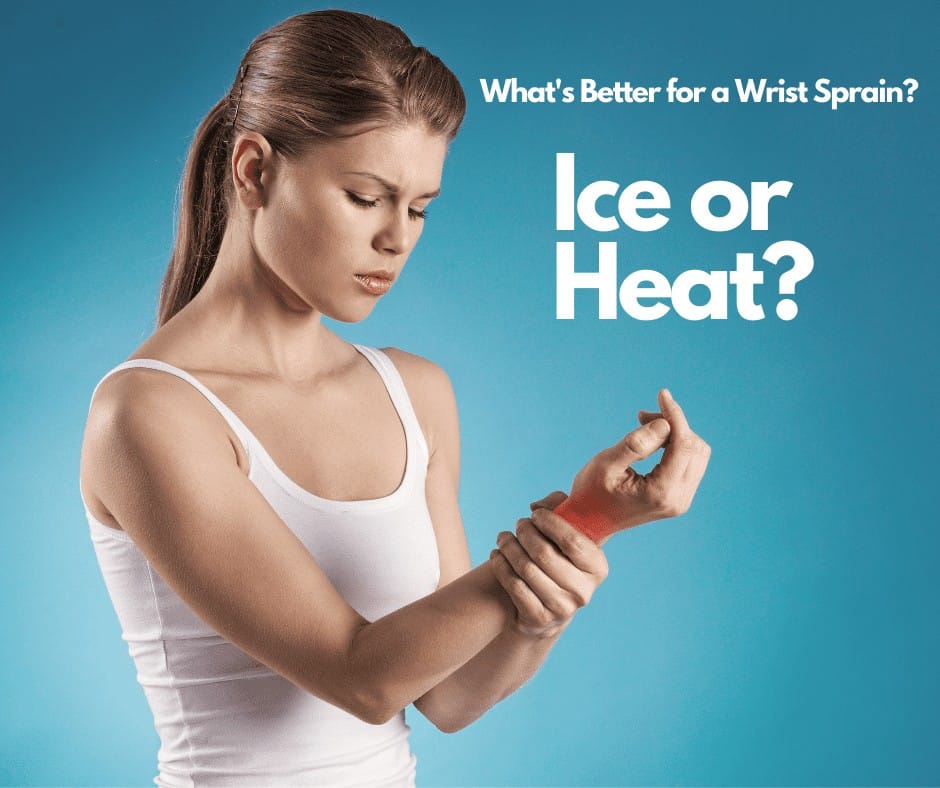Ice packs and heating pads are common treatments for wrist sprains. Understanding the type of sprain you have will determine the best course of action.
Acute vs Chronic Wrist Sprains

The most commonly sprained ligaments in the wrists are those that join the eight small carpal bones to the two ends of the long bones of the forearm (radius and ulna). When any of these ligaments are injured, pain, swelling, bruising, stiffness, loss of strength, or difficultly with wrist movements can develop. In other words, activities of daily living can become burdensome.
Chronic wrist sprains most often occur in athletes or those whose occupations require heavy lifting or repetitive motion.
Acute wrist sprains are often the result of a sudden force that puts pressure on your wrist improperly. Examples are getting up the “wrong way” from a chair or bending your wrist backwards due to a fall onto your outstretched hand. This type of sprain can be mild to severe depending on how severely the ligament (tissue that connects bone to bone) is pulled or torn away.
According to Medline Plus: Acute wrist sprains are divided into 3 sub-types:
- Grade 1 – Ligaments are stretched too far, but not torn. This is a mild injury.
- Grade 2 – Ligaments are partially torn and some loss of function will result. This is a moderate injury and may require splinting or casting to stabilize the joint.
- Grade 3 – Ligaments are completely torn. This is a severe injury and usually requires medical or surgical attention.
Ice or Heat?
For chronic wrist sprain injuries, apply a heat treatment for at least 30 minutes prior to engaging in activity is best. Heat or warmth will relax tissues and stimulate blood flow.
- An electric heating pad, a medical heat bandage or a heated towel removed from the dryer are effective treatments
- Use the moderate heat setting with an electric heating pad
- Heat should never cause sweating or discomfort
- Sometimes moist heat provides better pain relief than dry heat, but use caution as overheating a microwavable bag or a steamed towel can cause burns
- Never use heat where there is swelling of any kind or on broken/damaged skin
- Speak with your certified hand therapist about what activity is causing you to re-injure your wrist and what you can do to prevent further injury. If a wrist brace is recommended, try our Bullseye Wrist Band for relief.
For acute wrist sprain injuries, apply a bag of ice, a medical ice bandage or something cold (like a bag of frozen peas) to the injury immediately. Cold will slow down the molecules in the tissues and reduce blood flow which will in turn reduce the inflammation.
- Always wrap the source of cold in some sort of fabric as extreme cold on bare skin can cause tissue damage
- Ensure any wrap isn’t so tight as to cut off circulation
- Until there is a noticeable decrease in soreness and inflammation, use cold/cool water for hand washing, bathing and showering. Any warmth can counteract the work of a cold compress and cause the inflammation to re-occur.
- Ice the wrist 3 or 4 times per day for 15-20 minutes
- If after 48 hours the swelling has not decreased or the injury does not seem to be healing as expected, consult a medical professional